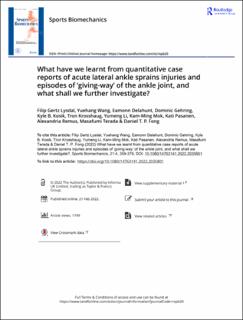| dc.contributor.author | Lysdal, Filip Gertz | |
| dc.contributor.author | Wang, Yuehang | |
| dc.contributor.author | Delahunt, Eamonn | |
| dc.contributor.author | Gehring, Dominic | |
| dc.contributor.author | Kosik, Kyle B. | |
| dc.contributor.author | Krosshaug, Tron | |
| dc.contributor.author | Li, Yumeng | |
| dc.contributor.author | Mok, Kam-Ming | |
| dc.contributor.author | Pasanen, Kati | |
| dc.contributor.author | Remus, Alexandria | |
| dc.contributor.author | Terada, Masafumi | |
| dc.contributor.author | Fong, Daniel Tik-Pui | |
| dc.date.accessioned | 2022-03-22T22:06:46Z | |
| dc.date.available | 2022-03-22T22:06:46Z | |
| dc.date.created | 2022-02-24T21:43:24Z | |
| dc.date.issued | 2022 | |
| dc.identifier.citation | Sports Biomechanics. 2022, 21(4), Side 359-379. | en_US |
| dc.identifier.issn | 1476-3141 | |
| dc.identifier.uri | https://hdl.handle.net/11250/2986928 | |
| dc.description | This is an Open Access article distributed under the terms of the Creative Commons Attribution-NonCommercial-NoDerivatives License (http://creativecommons.org/licenses/by-nc-nd/4.0/), which permits non-commercial re-use, distribution, and reproduction in any medium, provided the original work is properly cited, and is not altered, transformed, or built upon in any way. | en_US |
| dc.description.abstract | Lateral ankle sprains are a commonly incurred injury in sports. They have a high recurrence rate and can lead to the development of persistent injury associated symptoms. We performed a quantitative synthesis of published case reports documenting the kinematics of acute lateral ankle sprains and episodes of ‘giving-way’ of the ankle joint to provide a comprehensive description of the mechanisms. A systematic literature search was conducted to screen records within MEDLINE® and EMBASE®. Additional strategies included manual search of specific journals, as well as contacting researchers in relevant communities to retrieve unpublished data. Twenty-four cases were included in the quantitative synthesis, 11 from individual case reports and 13 from four separate case series. Two authors independently reviewed all the articles and extracted ankle joint kinematic data. Excessive ankle inversion was the most pronounced kinematic pattern observed across all included cases, with a mean peak inversion angle of 67.5° (range 2.0 to 142) and a mean peak inversion velocity of 974°/s (range 468 to 1752). This was followed by internal rotation and plantar flexion, respectively. A homogeneous linear function revealed a mean inversion velocity across all cases of 337°/s (range 117 to 1400; R2 = 0.78; p < 0.0001). | en_US |
| dc.language.iso | eng | en_US |
| dc.subject | ankle injuries | en_US |
| dc.subject | case reports | en_US |
| dc.subject | lower extremity | en_US |
| dc.subject | review of reported cases | en_US |
| dc.subject | sports | en_US |
| dc.subject | sprains and strains | en_US |
| dc.title | What have we learnt from quantitative case reports of acute lateral ankle sprains injuries and episodes of ‘giving-way’ of the ankle joint, and what shall we further investigate? | en_US |
| dc.type | Peer reviewed | en_US |
| dc.type | Journal article | en_US |
| dc.description.version | publishedVersion | en_US |
| dc.rights.holder | © 2022 The Author(s) | en_US |
| dc.source.pagenumber | 359-379 | en_US |
| dc.source.volume | 21 | en_US |
| dc.source.journal | Sports Biomechanics | en_US |
| dc.source.issue | 4 | en_US |
| dc.identifier.doi | 10.1080/14763141.2022.2035801 | |
| dc.identifier.cristin | 2005341 | |
| dc.description.localcode | Institutt for idrettsmedisinske fag / Department of Sports Medicine | en_US |
| cristin.ispublished | true | |
| cristin.fulltext | original | |
| cristin.qualitycode | 1 | |
